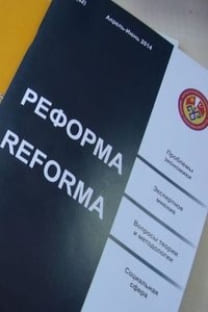KIRGIZİSTAN’DA DIŞ TİCARETİN EKONOMİK BÜYÜMEYE ETKİLERİ
ihracat, ithalat, gayri safi yurtiçi hasıla, Kırgızistan
IMPACT OF FOREIGN TRADE TO ECONOMIC GROWTH IN KYRGYZSTAN
export, import, gross domestic product, Kyrgyzstan,
___
- Abbas Sh. (2012). Causality between Exports and Economic Growth: Investigating Suitable Trade Policy for Pakistan. Eurasian Journal of Business and Economics 2012, 5 (10), 91-98.
- Baldwin R.E. (2000). Trade and Growth: Still Disagreement About The Relationships. Economics Department Workıng Papers No. 264. OECD.
- Engle, Robert F. & Clive W.J. Granger, (1987), “Co-integration and Error Correction: Representation, Estimation, and Testing”, Econometrica 55, pp. 251-276.
- Grossman H. (1991). Trade, innovation and growth. American Economic Review, Vol.80, 86-91.
- Güngör B. ve Kurt S. (2007). Dışa Açıklık ve Kalkınma İlişkisi (1968-2003): Türkiye Örneği. İktisadi ve İdari Bilimler Dergisi, Cilt: 21 Sayı: 2, 197-210.
- Hatemi-j, A. (2002). Export Performance & Economic Growth Nexus in Japan: a Bootstrap Approach. Japan and World Economy, 14, 25-33.
- Kadı F. (2006). Büyümenin İtici Gücü Olarak Dış Ticaret: Kırgızistan Örneği. (Yayınlanmamış Doktora Tezi). Kırgızistan-Türkiye “Manas” Üniversitesi, Sosyal Bilimler Enstitüsü, İktisat Anabilim Dalı. Bişkek. 232 sayfa.
- Pistoresi B. and Rinaldi A. (2011). Exports, growth and causality. New evidence on Italy: 1863-2004. The Economic History Society Annual Conference, University of Cambridge, 1-3 April 2011.
- http://www.ehs.org.uk/dotAsset/01fc9653-2ca7-42d8-821b-88e656cd433e.doc (erişim: 22.02.2014).
- Ramos, F. F. (2001). Exports, imports, and economic growth in Portugal: evidence from causality and cointegration analysis. Economic Modelling, 18, 613-623.
- Rivera-Batiz L.A. and P.M. Romer. (1991). Economic İntegration And Endogenous Growth. The Qurterly Journal of Economics Vol.106/2, 531-555.
- Rodriguez F. and D. Rodrik (1999). Trade Policy and Economic Growth: A Skeptic’s Guide to the Cross-Country Evidence. Centre for Economic Policy Research, Discussion Paper Series, No. 2143.
- Thornton, J. (1997). Exports and economic growth: Evidence from 19th Century Europe. Economic Letters, 55, 235-240.
- Yardımcıoğlu F. ve Gülmez A. (2013). Türk Cumhurıyetleri’nde İhracat ve Ekonomik Büyüme İlişkisi: Panel Eşbütünleşme ve Panel Nedensellik Analizi. Bilgi Ekonomisi ve Yönetimi Dergisi, Cilt: VIII Sayı: I, 145-161.
- ISSN: 1694-5158
- Yayın Aralığı: Yılda 2 Sayı
- Başlangıç: 1999
- Yayıncı: Kırgızistan Türkiye Manas Üniversitesi
MANAGEMENT OF LOCAL GOVERNMENT FINANCIAL RECOURSES IN KYRGYZSTAN
KIRGIZİSTAN’DA DIŞ TİCARETİN EKONOMİK BÜYÜMEYE ETKİLERİ
Damira BAYGONUŞOVA, Nurlan ATABAEV, Junus GANİEV
TRENDS OF REPRODUCTION PROCESSES IN THE TRANSFORMATIONAL PERIOD IN THE KYRGYZ REPUBLIC
ECONOMIC ANALYSIS OF THE HEALTHCARE SYSTEM IN THE KYRGYZ REPUBLIC
THE LACK OF STATE THINKING – A THREAT TO NATIONAL INTERESTS AND SECURITY OF KYRGYZSTAN
MICROCREDIT AS A WAY OF REDUCTION OF POVERTY IN KYRGYZSTAN
KIRGIZ CUMHURİYETİ’NDEN YAPILAN DIŞ GÖÇÜ ETKİLEYEN FAKTÖRLERİN BELİRLENMESİ
Recep TARI, Burulça SULAYMANOVA
KIRGIZİSTAN’DA MESLEK YÜKSEKOKULU ÖĞRENCİLERİNİN GİRİŞİMCİLİK EĞİLİMLERİ
Bülent BAYRAKTAR, Gülnara KARADENİZ
ISSUES OF DEVELOPMENT OF KYRGYZ REPUBLIC’S TRANSIT POTENTIAL
